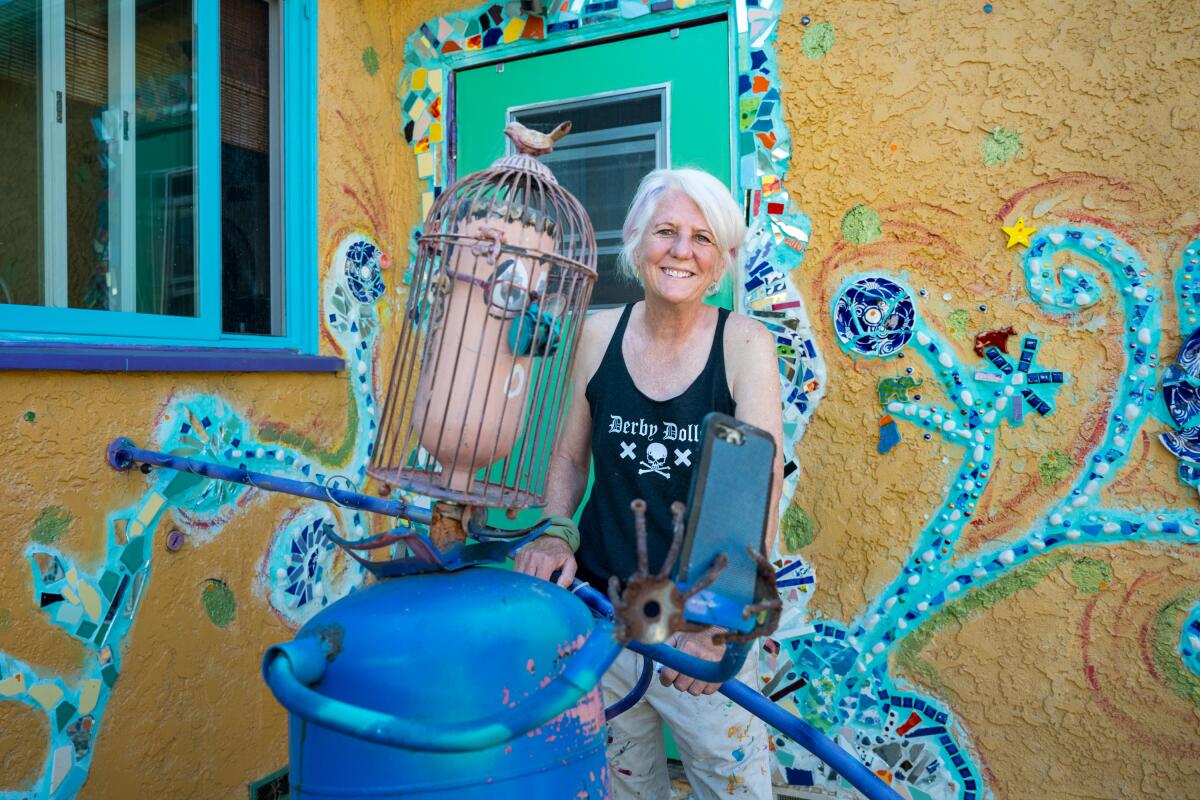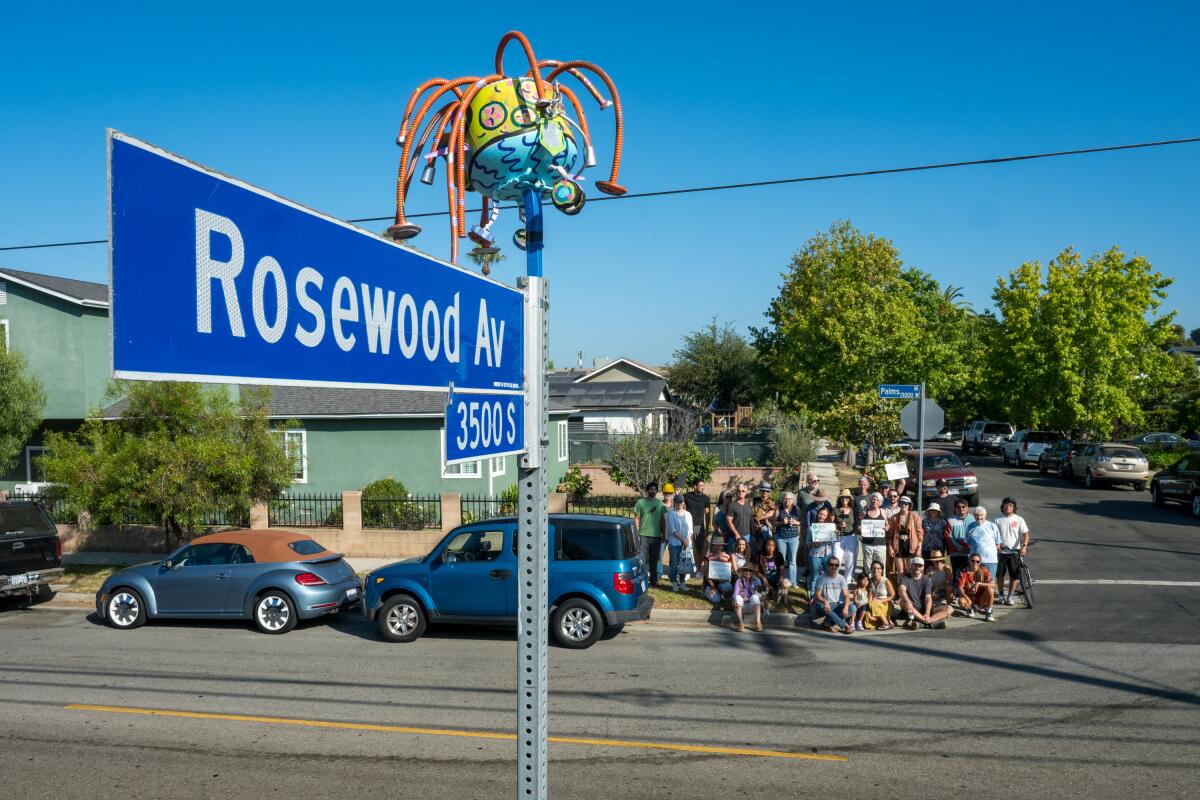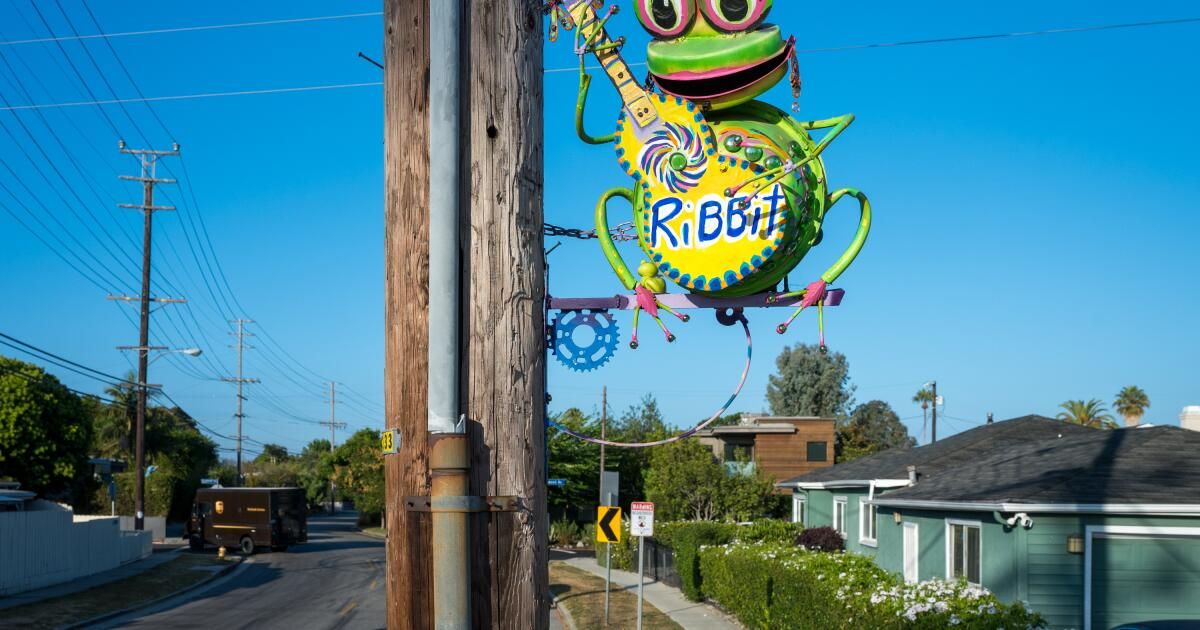The big Mar Vista street art skirmish took place shortly after 8 a.m. Tuesday.
Neighbors who love the whimsical metal sculptures that artist Lori Powers has stealthily placed on utility poles since 2017 confronted Los Angeles Department of Water and Power workers in hard hats who were busy unscrewing one of her signature pieces.
No one on either side seemed happy.
Opinion columnist
Robin Abcarian
“We need to chain our bodies to the poles,” Powers, 67, told the more than two dozen neighbors gathered outside her home before several gleaming white DWP trucks pulled up a block away.
“I swear to God I will,” said Scott Baldyga, 55, a novelist and screenwriter who has lived in the area for 13 years. The sculptures, he said, many of which entertain commuters on Palms Boulevard between Walgrove and Beethoven avenues, make the neighborhood feel “like home.”
Paul Von Blum, a retired UCLA professor and neighbor who has written and taught about Powers’ art, approached the DWP workers, who had begun dismantling one of the pieces. “Why are you doing this?” he asked indignantly. “Are you just following orders?”
They didn't respond, but their supervisor, Dan Grout, politely asked Von Blum to move away from the truck.

Lori Powers and one of her sculptures in the backyard of her Mar Vista home.
(Michael Owen Baker/For The Times)
Last week, neighbours had been informed that the artworks, which another neighbour had complained about (no one, including the DWP, could tell me), were to be removed. In response, Powers' supporters organised a social media and email campaign to save the artworks.
But Powers and her allies, including former Los Angeles City Councilwoman Ruth Galanter, had been led to believe that the DWP had given them a reprieve, pending the return this week of the borough's current councilwoman, Traci Parks, who was in Paris for the Olympics.
Grout, however, told me he was not aware of any change of plans and understandably hinted that he had been dreading this assignment. “Last weekend, I was thinking, ‘This is going to be a fun job,’” he said ruefully.
A few minutes later, after a phone call or two, Grout told his crews to “get this over with,” and soon the men in helmets and shiny white pickup trucks were gone.
Of the 28 sculptures, all but two have been saved. At least for now.
A few hours after everyone had left, I drove back to the intersection of Rosewood Avenue and Marco Place.
Powers had just finished reinstalling “Beam Love,” one of the artworks the DWP had removed.
“Beam Love” is made from a toolbox attached to a small fire extinguisher. It has large eyes made from the grate of a Coleman camp stove and eyelashes salvaged from a neighbor’s leftover artificial turf. Flat glass marbles on the extinguisher “body” sparkled in the sunlight. Each of Powers’ pieces contains a gold sports medallion, usually camouflage, in homage to his years playing for an award-winning three-on-three women’s basketball team. “It’s my signature,” he said.
His imaginative creations, some with comforting messages like “Be You,” are welded together from all sorts of discarded materials, painted bright colors and fastened securely to power poles with bolts and four-inch chains. He says he inspects them weekly and repaints and repairs them when necessary.
She started making them after retiring from her career as an IT consultant and realizing she needed a hobby. She took up welding and soon her imaginative works of art evolved.
I had been alerted to this brouhaha last week, when Galanter emailed me. She represented this neighborhood during her 16 years on City Hall and has little patience for obstinate bureaucracy. She had reached out to Parks’ office and was told by one of the councillor’s staffers that an anonymous DWP employee had outlined the department’s unwavering position in an email, which Galanter forwarded to me:
“The attached items are illegal,” the vaguely threatening email from the DWP said. “We have chosen not to pursue civil or criminal action at this time. We are simply removing the items as quickly as possible to mitigate the clear and present safety hazards to utility workers who may have to access the pole, and to mitigate any damage they may have caused to the pole by illegally climbing and illegally placing items on it. We are not making any statements regarding this. We are not meeting with constituents regarding this matter. We assume no liability for any damage to or destruction of the illegal items.”
I could practically hear Galanter babbling.
“There is no doubt that art on poles is illegal,” she told me. “But so what? There is a process to legalize it. And if anyone cared, they would do it.” I am not sure there is. is a real procedure, but I see your point: Angelenos need to remember that they can push the city in any directions they choose.

Mar Vista residents gathered to support the art and the artist on Tuesday.
(Michael Owen Baker/For The Times)
As examples, Galanter reminded me that during her tenure, the city had planned to tear down the storm-damaged Venice Pier, until Galanter, the Coastal Conservancy and her constituents fought to save it. Rebuilding the pier helped revitalize nearby shops and restaurants in what is now called Washington Square. And that city engineers once refused to install a stop sign on Rose Avenue in front of the Venice Family Clinic because there wasn’t enough car traffic — until she pointed out that the issue was pedestrian safety.
On Tuesday afternoon, DWP communications director Elena Stern took a softer tone but said the department was firmly committed to removing Powers' pieces. The state Public Service Commission sets the rules, she said, and prohibits foreign objects from being on poles.
“We want to find a solution that is beneficial for everyone,” Stern said, though it’s unclear what that would entail — perhaps moving the sculptures to a more welcoming public space. “We have to be respectful, we’re ready to exchange ideas and listen to the community.”
No matter what happens, at least Powers knows that his neighbors (well, most of them) are big fans.
“I’ve received so much love and support,” Powers said, “I probably won’t have to go to therapy this week.”
@robinkabcarian












